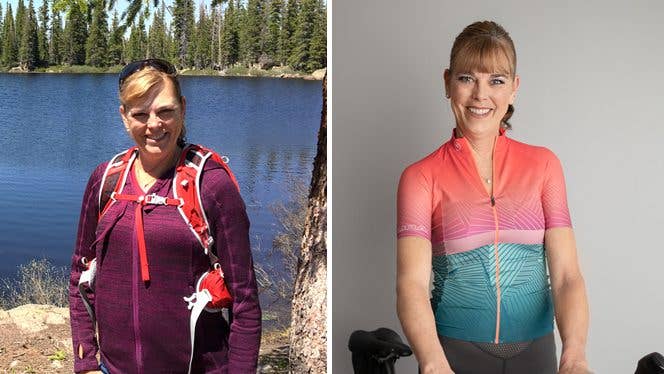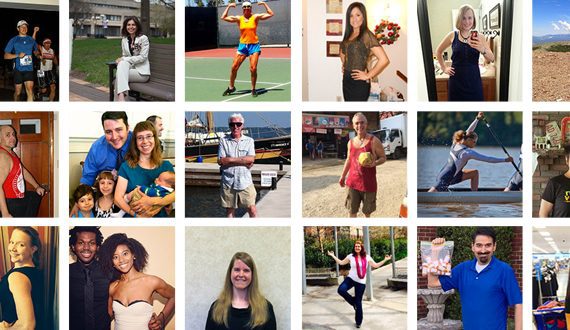
A Widowmaker Cardiac Event Was the Wake-Up Call I Needed to Change My Diet
By Sharon Dunmall,
Biking in the Colorado mountains can be challenging any day. But on Aug. 1, 2018, it was life-changing.
My husband, Chris, and I enjoy an adventure-filled lifestyle and spend our weekends hiking and biking, and when biking, we always ride together—but on this day I couldn’t keep up with him. It was especially strange considering that I had recently completed a 42-mile ride.
I kept telling Chris that something was not right. A heaviness in my chest made it difficult to breathe, and I had to stop multiple times. I attributed my shortness of breath to the fact that the mountain air was thick with smoke from wildfires. When we got home, I went to urgent care. They gave me an inhaler and sent me home.
The next day I called my primary doctor, and she had me come in for blood work. They put a rush on the lab order. She called me and told me to get to the emergency room immediately.
Chris and I rushed to the ER, and I ended up in the cardiac cath lab, where the doctors told me that I was lucky to be alive. My left anterior descending (LAD) artery was 98 percent clogged. (Because the LAD artery is so essential in providing blood to the heart, this type of heart attack is often referred to as a “widowmaker.”) Fortunately, the docs got to me in the nick of time and were able to put a stent in, and I survived without any permanent damage to my heart. I was grateful to have received the care I needed in that moment. Chris and I later learned that symptoms of heart disease in women can be profoundly different from symptoms in men, and even trained medical professionals can fail to see the signs.
My doctor told us that our active lifestyle was great but that it wouldn’t be able to fix the damage that the standard American diet had done to my endothelial cells and arteries; I’d need to switch to a plant-based no-oil diet.
Chris researched Dr. Caldwell Esselstyn, MD, and his book Prevent and Reverse Heart Disease. We also read The China Study by T. Colin Campbell, PhD, and decided that a whole-food, plant-based lifestyle was the best one for preventing another heart event.
Making the Switch
The transition was not easy. We watched hours of videos and bought every book and magazine we could find about WFPB living. I cleaned out the fridge and the cupboards, removing all highly processed foods and animal products. For me, it was emotionally distressing: I had loved these foods, and now I saw cookies, meats, and dairy products as a threat. It was hard to stay on track at first, especially in social settings when friends would eat rich meals that I couldn’t share in.
But Chris and I always support and encourage each other, which is a big part of our success story, and we invested in educational resources to support our new lifestyle. I completed the Plant-Based Nutrition Certification program through eCornell, and Chris took a professional plant-based chef course. Together we learned how to cook with new plant-based ingredients. At first we ate faux meats and cheeses; those were our gateway. But over time we learned how to cook veggies properly and mastered no-oil cooking. We sought out vegan restaurants and learned how to order healthy meals at non-vegan restaurants.
We both started to see the benefits soon after making the switch. We felt better—less fatigued and no bloating. Over the next few weeks, we lost a combined 40 pounds. I got a whole new wardrobe because I was a dress size I hadn’t been in 20 years. Chris began wearing a belt he’d gotten in high school. We felt energized and encouraged. Just three months after my heart event, we hiked the Kumano Kodo across Japan.
Four Years Later
Today, four years after my heart event, I know that the food you put into your mouth can either hurt you or heal you. Looking back, I see that many family members and friends who suffered and died of heart disease, type 2 diabetes, and cancer were victims of the food they ate. My heart disease was not from my family’s genes; it was from a tradition of eating meals centered on animal products, dairy, and highly processed foods. My life has changed since changing my diet, and now when we go hiking and biking, I am passing Chris on the hills.
Ready to get started? Check out Forks Meal Planner, FOK’s easy weekly meal-planning tool to keep you on a healthy plant-based path. To learn more about a whole-food, plant-based diet, visit our Plant-Based Primer.
Has a whole-food, plant-based diet impacted your life?
We would love to hear about it!
SHARE YOUR STORY
Free Download
Free 5-day meal plan!
Get a taste for healthy, fuss-free meal planning with this free five-day meal plan from Forks Meal Planner!
By providing your email address, you consent to receive newsletter emails from Forks Over Knives. We value your privacy and will keep your email address safe. You may unsubscribe from our emails at any time.

Join our mailing list
Get free recipes and the latest info on living a happy, healthy plant-based lifestyle.
By providing your email address, you consent to receive newsletter emails from Forks Over Knives. We value your privacy and will keep your email address safe. You may unsubscribe from our emails at any time.
